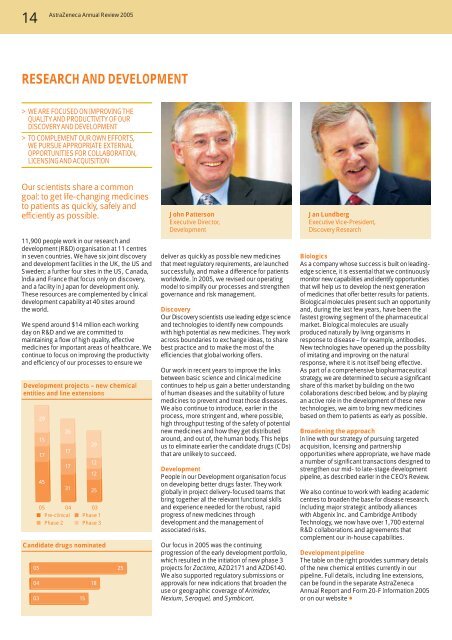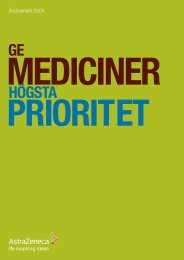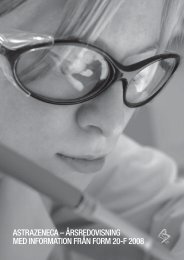AstraZeneca Annual Review 2005 - AstraZeneca Annual Reports
AstraZeneca Annual Review 2005 - AstraZeneca Annual Reports
AstraZeneca Annual Review 2005 - AstraZeneca Annual Reports
Create successful ePaper yourself
Turn your PDF publications into a flip-book with our unique Google optimized e-Paper software.
14<strong>AstraZeneca</strong> <strong>Annual</strong> <strong>Review</strong> <strong>2005</strong>RESEARCH AND DEVELOPMENT> WE ARE FOCUSED ON IMPROVING THEQUALITY AND PRODUCTIVITY OF OURDISCOVERY AND DEVELOPMENT> TO COMPLEMENT OUR OWN EFFORTS,WE PURSUE APPROPRIATE EXTERNALOPPORTUNITIES FOR COLLABORATION,LICENSING AND ACQUISITIONOur scientists share a commongoal: to get life-changing medicinesto patients as quickly, safely andefficiently as possible.11,900 people work in our research anddevelopment (R&D) organisation at 11 centresin seven countries. We have six joint discoveryand development facilities in the UK, the US andSweden; a further four sites in the US, Canada,India and France that focus only on discovery,and a facility in Japan for development only.These resources are complemented by clinicaldevelopment capability at 40 sites aroundthe world.We spend around $14 million each workingday on R&D and we are committed tomaintaining a flow of high quality, effectivemedicines for important areas of healthcare. Wecontinue to focus on improving the productivityand efficiency of our processes to ensure weDevelopment projects – new chemicalentities and line extensions0504032915174526171731152912122505 04 03Pre-clinical Phase 1Phase 2 Phase 3Candidate drugs nominated1825John PattersonExecutive Director,Developmentdeliver as quickly as possible new medicinesthat meet regulatory requirements, are launchedsuccessfully, and make a difference for patientsworldwide. In <strong>2005</strong>, we revised our operatingmodel to simplify our processes and strengthengovernance and risk management.DiscoveryOur Discovery scientists use leading edge scienceand technologies to identify new compoundswith high potential as new medicines. They workacross boundaries to exchange ideas, to sharebest practice and to make the most of theefficiencies that global working offers.Our work in recent years to improve the linksbetween basic science and clinical medicinecontinues to help us gain a better understandingof human diseases and the suitability of futuremedicines to prevent and treat those diseases.We also continue to introduce, earlier in theprocess, more stringent and, where possible,high throughput testing of the safety of potentialnew medicines and how they get distributedaround, and out of, the human body. This helpsus to eliminate earlier the candidate drugs (CDs)that are unlikely to succeed.DevelopmentPeople in our Development organisation focuson developing better drugs faster. They workglobally in project delivery-focused teams thatbring together all the relevant functional skillsand experience needed for the robust, rapidprogress of new medicines throughdevelopment and the management ofassociated risks.Our focus in <strong>2005</strong> was the continuingprogression of the early development portfolio,which resulted in the initiation of new phase 3projects for Zactima, AZD2171 and AZD6140.We also supported regulatory submissions orapprovals for new indications that broaden theuse or geographic coverage of Arimidex,Nexium, Seroquel, and Symbicort.Jan LundbergExecutive Vice-President,Discovery ResearchBiologicsAs a company whose success is built on leadingedgescience, it is essential that we continuouslymonitor new capabilities and identify opportunitiesthat will help us to develop the next generationof medicines that offer better results for patients.Biological molecules present such an opportunityand, during the last few years, have been thefastest growing segment of the pharmaceuticalmarket. Biological molecules are usuallyproduced naturally by living organisms inresponse to disease – for example, antibodies.New technologies have opened up the possibilityof imitating and improving on the naturalresponse, where it is not itself being effective.As part of a comprehensive biopharmaceuticalstrategy, we are determined to secure a significantshare of this market by building on the twocollaborations described below, and by playingan active role in the development of these newtechnologies, we aim to bring new medicinesbased on them to patients as early as possible.Broadening the approachIn line with our strategy of pursuing targetedacquisition, licensing and partnershipopportunities where appropriate, we have madea number of significant transactions designed tostrengthen our mid- to late-stage developmentpipeline, as described earlier in the CEO’s <strong>Review</strong>.We also continue to work with leading academiccentres to broaden the base for disease research.Including major strategic antibody allianceswith Abgenix Inc. and Cambridge AntibodyTechnology, we now have over 1,700 externalR&D collaborations and agreements thatcomplement our in-house capabilities.Development pipelineThe table on the right provides summary detailsof the new chemical entities currently in ourpipeline. Full details, including line extensions,can be found in the separate <strong>AstraZeneca</strong><strong>Annual</strong> Report and Form 20-F Information <strong>2005</strong>or on our website •




